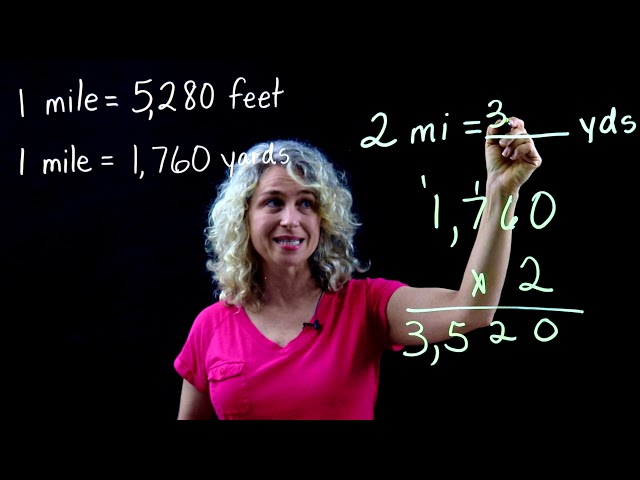Unveiling the Yardstick: A Comprehensive Exploration of Miles and Yards
The world around us unfolds in a tapestry of distances, from the subatomic realm to the vast expanse of the cosmos. Accurately measuring these distances is crucial for countless endeavors, from constructing buildings to navigating uncharted territories. This article delves into the fascinating world of distance measurement, focusing on the relationship between miles and yards, two fundamental units used in the Imperial system.
Miles: A Journey Through History
The concept of the mile has a rich history, tracing its roots back to ancient civilizations:
- Roman Roots: The Roman mile (mille passus) was the first widely used unit for measuring long distances. It was originally defined as the number of paces taken by a Roman soldier in 1,000 double paces (2,000 steps). Estimates suggest a Roman mile was roughly equal to 1,618 meters (5,308 feet).
- Medieval Mile Variations: During the Middle Ages, the definition of the mile varied across Europe. Some were based on the Roman mile, while others were derived from the distance a plow could travel in a certain amount of time. This inconsistency created challenges in trade and travel.
- Standardization Efforts: In the 16th and 17th centuries, attempts were made to standardize the mile. In England, Queen Elizabeth I defined the statute mile in 1581 as 8 furlongs, with a furlong equating to 220 yards. This definition, based on a specific number of paces, remained in use for centuries.
- The International Yard and Pound Agreement: The 1959 International Yard and Pound Agreement redefined the mile based on the meter, the SI unit of length. One international mile is now exactly equal to 1,609.344 meters.
Understanding Yards: A Unit Rooted in Action
The yard, a smaller unit within the Imperial system, has its own historical journey:
- Action-Based Origins: The yard likely originated from the distance between a man’s outstretched arm and his thumb tip, a readily available measuring tool in everyday life.
- Variations in Yard Length: Similar to the mile, the definition of the yard varied across time and location. Some were based on the length of the king’s arm or yardstaff, leading to inconsistencies.
- Standardization of the Yard: The International Yard and Pound Agreement of 1959 also standardized the yard. One international yard is now defined as exactly 3 feet, with the foot itself being defined based on the meter.
Bridging the Gap: Converting Miles to Yards
Since both miles and yards are established units within the Imperial system, a straightforward conversion factor exists between them.
- 1 mile is equal to 1,760 yards.
This conversion factor allows us to easily translate distances between miles and yards. Here’s a formula to perform the conversion:
Target Unit (yards) = Source Value (miles) * 1,760 (conversion factor)
Example: Convert 2.25 miles to yards.
- Target Unit: Yards
- Source Value: 2.25 miles
- Conversion Factor: 1,760 yards/mile
Calculation: 2.25 miles * 1,760 yards/mile = 3,960 yards
Practical Applications: When Miles and Yards Matter
Understanding the relationship between miles and yards is essential in various real-world scenarios:
- Construction and Engineering: Construction plans and architectural drawings often use yards for smaller dimensions and miles for larger distances (e.g., property boundaries).
- Sports Fields: Football fields are typically measured in yards (100 yards long), while baseball fields use a combination of feet and yards (90 feet between bases).
- Landscaping and Gardening: Landscaping projects and garden layouts frequently rely on yard measurements for planning and material calculations.
- Everyday Estimations: We might estimate the distance to a nearby store in yards for a quick walk or jog.
Beyond the Basics: Exploring Additional Units and Conversions
The Imperial system comprises various units of distance besides miles and yards. Here’s a brief overview:
- Feet: One yard is divided into 3 feet. Feet are commonly used for smaller measurements like furniture dimensions or carpentry projects.
- Inches: One foot is further divided into 12 inches. Inches are ideal for very small measurements like screw sizes or precise woodworking.
- Rods, Chains, and Furlongs: These are less commonly used units, with 16.5 feet in a rod, 66 feet in a chain (4 rods), and 220 yards in a furlong. Understanding these historical units can provide.
Cultural Connections: Yards and the Human Experience
Beyond their practical applications, miles and yards hold cultural significance in various ways:
- Folktales and Proverbs: Many cultures have proverbs and folktales that use units of distance to convey meaning. Phrases like “an inch at a time” (referring to gradual progress) or “yardstick” (a standard for measurement) demonstrate how these units permeate our understanding.
- Textile Industry: The yard remains a relevant unit in the textile industry for measuring fabric length.
- Golf Courses: Golf courses use yardage markers to indicate the distance from the tee box to the green for each hole, helping golfers strategize their shots.
The Ongoing Debate: Metric vs. Imperial
The world is divided between the metric system and the Imperial system. The metric system, based on the meter, is the dominant system of measurement used by most countries. However, the United States and a few other countries continue to use the Imperial system.
There are several arguments for and against each system:
Arguments for the Metric System:
- Simplicity: The metric system is based on a base-10 system, making conversions between units straightforward.
- Global Standardization: The vast majority of the world uses the metric system, fostering international communication and trade.
- Scientific Precision: The metric system is the preferred system in scientific research due to its ease of use and clear definitions.
Arguments for the Imperial System:
- Familiarity: People accustomed to the Imperial system may find it easier to visualize and understand distances in those units.
- Gradual Change: Shifting to a new system entirely can be a complex and expensive undertaking.
- Industry Standards: Some industries within the United States, such as construction, are deeply entrenched in using the Imperial system.
The debate over which system to use is likely to continue for some time. However, understanding both the metric system and the Imperial system, particularly the relationship between miles and yards, can be a valuable asset in a globalized world.
Frequently Asked Questions (FAQ)
- Why do we use a base-10 system for the metric system, but not the Imperial system?
The exact reason for the Imperial system’s base-non-ten origins is unclear. Theories suggest it might be due to historical influences from various civilizations and the practicality of dividing units into whole numbers for certain applications.
- How do I convert between miles and kilometers?
One mile is approximately equal to 1.609 kilometers. To convert miles to kilometers, you can multiply the number of miles by 1.609. Conversely, to convert kilometers to miles, divide the number of kilometers by 1.609.
- What are some other units of distance used in the Imperial system?
As mentioned earlier, the Imperial system includes units like feet (12 inches in a foot) and inches (further dividing a foot). Additionally, there are less commonly used units like rods (16.5 feet), chains (4 rods or 66 feet), and furlongs (220 yards).
- Is the United States ever likely to switch to the metric system?
There have been discussions and proposals for the United States to adopt the metric system, but there is no clear consensus or timeline for such a change.
By delving into the history, applications, and cultural significance of miles and yards, this article equips you with a comprehensive understanding of these fundamental units of distance measurement.



